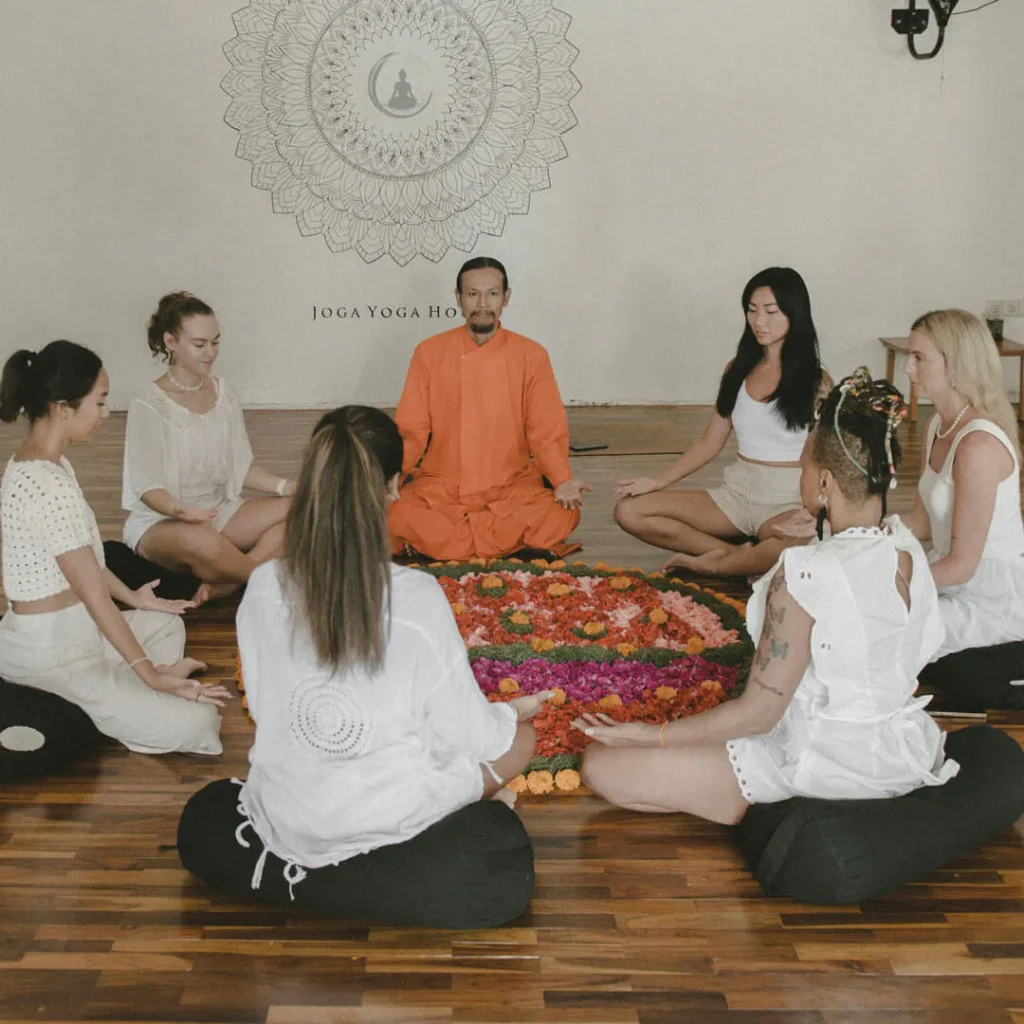In the practice of yoga and ancient Vedic traditions, the term Sankalpa holds profound meaning. Rooted in Sanskrit, Sankalpa can be understood as “intention” or “resolve.” Unlike typical goal-setting, which focuses on external achievements, Sankalpa is about connecting deeply with your inner purpose. It represents a powerful commitment to yourself, an internal vow that aligns with your true desires and aspirations. Sankalpa provides a framework to cultivate focus and bring about meaningful change in one’s life by harnessing the power of positive, present-tense affirmations.
What is Sankalpa?

At its core, Sankalpa is about the resolution to move toward a desired state of being. It is rooted in the Vedic traditions, where the mind is seen as a potent tool for manifesting one’s deepest desires. Unlike traditional goals or New Year’s resolutions, typically tied to external outcomes, Sankalpa focuses on cultivating an internal shift. It is not just about achieving something in the future; rather, it is a present-tense affirmation that you already possess the qualities and strengths you need.
A Sankalpa differs from other intentions by its profound connection to your inner self. Rather than wishful thinking, it is an intentional declaration of who you are and what you wish to embody in the present moment. This practice, used in Yoga Nidra and other meditative traditions, allows practitioners to harness the power of intention to support personal growth and transformation.
Sanskrit Roots and Meaning
The word “Sankalpa” originates from the Sanskrit root “kalp,” which signifies “to think, to imagine, to plan, or to conceive.” The prefix “sam” denotes “together” or “completely.” Thus, “Sankalpa” can be interpreted as “to think together” or “to conceive completely.” This etymological breakdown highlights the core essence of Sankalpa as a process of bringing together thoughts and intentions to form a firm resolution.
How Sankalpa Differs from Goal-Setting
It’s important to understand that a Sankalpa fundamentally differs from a typical goal or resolution. For instance, many people set New Year’s resolutions like “I’m going to give up alcohol” or “I’ll lose weight this year.” These resolutions are often focused on external outcomes and can feel rigid and difficult to sustain.
In contrast, a Sankalpa is more about internal alignment and less about external accomplishments. For example, instead of focusing on cutting out a habit, a Sankalpa related to health might be: “I nourish my body with foods and practices that support my well-being.” This subtle shift makes the practice more sustainable and rooted in personal empowerment rather than restriction.
The Role of Sankalpa in Yoga and Meditation Practices
One of the most common ways to integrate Sankalpa into daily life is through practices like yoga nidra. Yoga nidra, or “yogic sleep,” is a deep relaxation technique that allows the mind to enter a meditative state where your Sankalpa can take root. During this practice, your mind is highly receptive, making it ideal for repeating your Sankalpa and reinforcing your intention.
By incorporating your Sankalpa into your yoga or meditation routine, you create a powerful synergy between body, mind, and spirit. The regular repetition of your intention can help guide your thoughts, actions, and decisions, aligning them with your true purpose.
Examples of Sankalpa in Daily Life
Sankalpas can be highly personal and specific to different areas of life. Here are a few examples of how Sankalpa might manifest:
- Personal Growth: “I trust in my ability to make mindful decisions and grow through every experience.”
- Health: “My body is strong, healthy, and capable of supporting me through life’s challenges.”
- Parenting: “I am a present, patient, and loving parent, fully engaged in my children’s lives.”
Each of these Sankalpas reflects a deep commitment to living in alignment with one’s values and purpose, affirming the qualities that are already present within.
Key Principles of Creating a Powerful Sankalpa
While creating your own Sankalpa, it’s important to adhere to a few essential guidelines:
Clarity of Intention
When crafting a Sankalpa, ensure that your intention is clear and positive. Ambiguity dilutes its power. For example, instead of framing your Sankalpa in vague terms, such as “I want to be happier,” phrase it as a clear intention like “I am embracing joy and positivity in my daily life.” This clarity enhances focus and channels your energy toward the manifestation of your desires.
Present Tense Affirmations
A key principle of Sankalpa is phrasing it in the present tense, affirming that your intention is already a reality. This reinforces the belief that you are already in the process of becoming the person you aspire to be. For instance, “I am healthy, strong, and full of vitality” is more effective than “I will become healthy.” The present-tense affirmation solidifies the connection between thought and reality, fostering positive transformation.
Confidence in Your Purpose
Confidence is essential when creating your Sankalpa. It’s vital to eliminate doubts and fully embrace the belief that your intention aligns with your purpose. A strong Sankalpa resonates with your deepest values and desires, reflecting your commitment to personal evolution. The more confident and clear you are in your Sankalpa, the stronger its potential impact.
Flexibility and Evolution
Although your Sankalpa is a powerful declaration of your current intentions, it can evolve over time. As your desires, goals, and circumstances change, so too can your Sankalpa. For example, you may start with a Sankalpa that focuses on physical health, but as you grow, it could shift toward emotional well-being or spiritual growth. The flexibility of this practice allows it to adapt to your evolving needs.
Crafting Your Own Sankalpa: Step-by-Step Guide
Creating your own Sankalpa is a deeply personal process. Here are the steps to guide you:
- Reflect on Your Desires: Consider what you truly want to bring into your life. Is it peace, strength, clarity, or something else?
- Clarify Your Intention: Use clear and concise language. What quality do you want to cultivate? Frame it in the present tense.
- Align With Your Purpose: Your Sankalpa should reflect your deepest aspirations and life goals. For example, if your goal is health, your Sankalpa could be: “I am healthy and vibrant.”
- Repeat Regularly: Consistently repeat your Sankalpa during meditation or quiet reflection to internalize the message and let it guide your thoughts and actions.
Philosophical Understanding of Sankalpa

Sankalpa, a Sanskrit term meaning “resolve” or “determination,” holds profound significance in various schools of Indian philosophy. It influences the path to spiritual liberation and self-realization. Understanding Sankalpa in these diverse philosophical frameworks provides valuable insights into its multifaceted nature and its role in shaping human consciousness and experience.
Sankalpa in Vedanta
Vedanta, the philosophical culmination of the Upanishads, explores the concept of Sankalpa as a mental construct that shapes our perception of reality. It emphasizes the interconnectedness of mind and matter, highlighting how our thoughts, beliefs, and intentions influence our experiences.
Vedanta posits that Sankalpa is a potent force that can either bind us to the cycle of birth and death or liberate us from it.
- The Role of Sankalpa in Maya: Vedanta describes the world as Maya, an illusion created by our own Sankalpa. This illusion obscures our true nature as Brahman, the ultimate reality. Our Sankalpa, rooted in ignorance (avidya), perpetuates the illusion, leading to suffering and attachment.
- The Power of Sankalpa in Liberation: However, Sankalpa can also be a tool for liberation. Through self-inquiry (atma-vichara) and meditation, we can become aware of our Sankalpa and its role in creating our experience. By cultivating a Sankalpa aligned with the truth of our being, we can transcend Maya and attain liberation.
Sankalpa in Yoga
Yoga, a system of physical, mental, and spiritual practices, emphasizes the importance of Sankalpa in achieving self-mastery and union with the divine. It recognizes Sankalpa as a powerful tool for shaping our thoughts, actions, and ultimately, our destiny.
- Sankalpa in Ashtanga Yoga: In the eight limbs of Ashtanga Yoga, Sankalpa is considered an essential aspect of the fifth limb, Niyama, which refers to observances and ethical principles. By setting a clear Sankalpa, we establish a firm intention that guides our practice and helps us overcome obstacles.
- Sankalpa in Kriya Yoga: Kriya Yoga, a powerful technique for spiritual transformation, utilizes Sankalpa as a vital element. Through focused intention and visualization, we direct our energy towards achieving our desired goal: physical healing, emotional well-being, or spiritual awakening.
Sankalpa in Buddhism
Buddhism, a philosophy that emphasizes the impermanence of all things, views Sankalpa as a form of mental conditioning that contributes to suffering. It recognizes that our thoughts and desires, including our Sankalpa, are constantly changing and influenced by external factors.
- Sankalpa and the Four Noble Truths: Buddhism’s Four Noble Truths state that suffering is inherent to life and that attachment, including attachment to our Sankalpa, causes suffering. By understanding Sankalpa’s nature, we can detach ourselves from its hold and alleviate suffering.
- Sankalpa in the Eightfold Path: The Eightfold Path, the Buddhist guide to liberation, emphasizes the importance of right intention (samyak-sankalpa) to cultivate mindfulness and compassion. Through right intention, we can direct our Sankalpa towards noble goals that benefit ourselves and others.
Why Sankalpa is More Than a Resolution
A Sankalpa is not a fleeting resolution but a lifelong practice that aligns with your belief system. It is a declaration of who you are and who you intend to be, grounded in your inner truth and supported by your confidence in personal transformation. By focusing on the present and aligning with your purpose, a Sankalpa transcends the short-term mindset of typical resolutions and becomes a powerful tool for long-term growth.
What is the meaning of Sankalpa?
Sankalpa is a Sanskrit word that translates to “intention” or “resolve.” It represents a deep commitment to aligning with one’s true purpose and manifesting personal transformation through focused intention.
How is Sankalpa different from a New Year’s resolution?
Unlike New Year’s resolutions, which often focus on external goals, Sankalpa is an internal affirmation that reflects your present state and deeper desires. It is rooted in personal growth rather than external accomplishments.
How do I create my own Sankalpa?
To create a Sankalpa, reflect on your deepest desires, use clear and concise language, and frame your intention in the present tense. Your Sankalpa should align with your true purpose and be repeated regularly for reinforcement.
Can I change my Sankalpa over time?
Yes, Sankalpa is flexible and can evolve as your goals and desires change. You are free to modify it to reflect your current aspirations while staying true to your core intentions.
How often should I practice my Sankalpa?
You can repeat your Sankalpa as often as you like. It can be integrated into your yoga or meditation practice, especially during Yoga Nidra, when the mind is more receptive.






